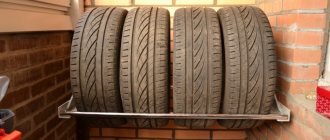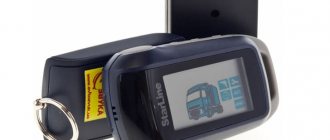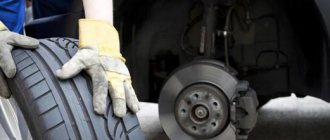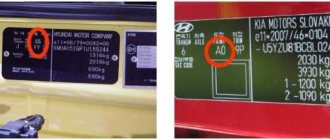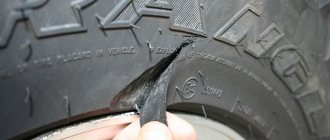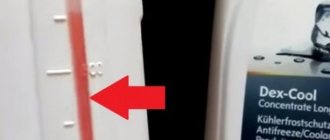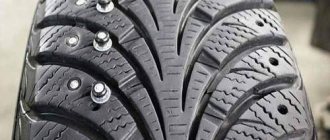How to find out the month and year of tire production?
Manufacturers indicate this information on the side of the wheel.
There is an oval stamp with a four-digit number. The first two digits indicate weeks from the beginning of the year (you can use them to find out the month of production), the second two digits indicate the year of production. For example, on the sidewall there is the number 1609. This means that 16 weeks have passed since the beginning of the year. By simple counting the month is determined - April. And the number 09 means 2009. It turns out that the tires were released in April 2009. There is also a three-digit marking. If you see such a stamp, it means the rubber was manufactured before 2000. In this digital combination, the first two values also indicate the week, and the third - the last digit of the year. For example, a tire is stamped with 169. This means that the manufacturer released it in April 1999 or 1989.
How can you find out the exact year? If the digital combination is framed on both sides with asterisks, then this is 1989. If there is a space or a small triangle after it, then the release date is 1999. Such difficulties are due to the fact that previously factories did not think that their tires would be used for more than 10 years.
Aging of automobile rubber
Tire manufacturers provide a 5-year warranty on their tires (this is the minimum). However, they can last much longer, maintaining the same elasticity, strength, reliability and other performance characteristics.
The rate of aging of tires depends on the conditions of their use, the quality of rubber raw materials, the chemical components contained in the structure of the material, and proper storage. Signs of aging tires:
- change in original color (rubber turns white);
- the appearance of microcracks on the sidewalls (their depth and size increase every year);
- deformation of the metal frame;
- loss of elasticity;
- formation of cracks and small clefts on the tread;
- the appearance of a small hernia.
If your tread is intact but showing other signs of aging, replace your tires immediately. Such consequences become possible due to the gradual release of special chemicals from the rubber composition that provide elasticity.
Initially, new tires have a characteristic smell. It is emitted by additional components. Once they evaporate, the rubber becomes harder and less elastic.
The aging process is accelerated by high humidity, direct exposure to sunlight, high temperature, and a combination of ozone and oxygen. These factors contribute to the breakdown of the strong bond between the rubber and the metal frame of the tire.
To greatly slow down the aging of tires, they are stored in plastic bags. This tightness prevents the rubber from interacting with the surrounding air and water. The sun's rays can no longer have a negative impact. With such storage, rubber can remain strong and elastic for 7-10 years.
Letter designations in tire names
Goodyear models sometimes contain additional data in the name indicating that the tire belongs to one category or another. Looking through the manufacturer's catalog, you may come across such designations as:
- SUV - tires designed for crossovers,
- Compact is a tire for small passenger cars,
- A/T - universal tires for city and off-road use,
- with Kevlar - speaks of strengthening the structure with special inserts that protect against punctures and cuts,
- SA - designates the use of Silent Armor technology, which improves off-road performance.
There are other letter abbreviations. The manufacturer usually gives a detailed explanation of the designation in the description of each model; you can see it, for example, in the official Goodyear online store.
Tire markings
On each tire you can find a set of signs and designations. At first glance, it may seem that the load parameters, tire design or tire size are very complex. But in fact, any motorist can understand the markings and decoding of a tire. Typically, the following characteristics can be found on tires:
- Tire type - this designation determines whether the tire is tubed or tubeless.
- Tire size - includes several dimensions: width, profile height and inner ring size. Usually indicated in the format 210/55-18.
- Load index - shows the maximum permissible maximum weight that wheels with maximum internal pressure can withstand.
- Manufacturer - this inscription is usually in large and noticeable letters. This indicator is the first thing motorists pay attention to when choosing tires.
- Seasonality - the designation All Season indicates the possibility of year-round use of such wheels.
- Speed index – shows the maximum permissible speed.
- The date of manufacture is usually indicated by a four-digit code, by which you can find out in what month and year the tires were produced.
- Weather Conditions – If you see umbrella markings on your tires, they are most likely designed for wet and rainy weather and have high aquaplaning protection.
About choosing tires
If you know what the markings on tires mean, you can easily choose the right tires. It is worth remembering that when choosing tires, you should first of all follow the recommendations of the manufacturer of your car. Usually it indicates detailed information about the size and other characteristics that car tires must meet. And markings will help you see additional parameters, such as technologies and improvements.
“Price From” refers to the suggested retail price of the product and may differ from the price offered by GOODYEAR dealers. The materials presented on this site are for informational purposes only and do not constitute a public offer in accordance with Article 437 of the Civil Code of the Russian Federation.
* Please check with your dealer for specific terms and conditions of each current promotion. The materials presented on this site are for informational purposes only and do not constitute a public offer in accordance with Article 437 of the Civil Code of the Russian Federation
Tire life
Most drivers know that there are two parts that you shouldn't skimp on in your car: brakes and wheels. Tires are a key element of your safety, as they provide traction and effective braking. Both your health and the service life of the car depend on how high quality and correctly selected they are. Therefore, the issue of choosing tires should always be approached with special care.
Over time, tires wear out, so it is necessary to replace them with new ones in time. It's better to do this a little earlier than to drive on tires that have worn down to the very base of the tread. What is the service life of tires? Of course, a lot depends on the operating conditions. But the maximum permissible period is considered to be 45 thousand kilometers. Experts no longer recommend delaying changing tires. Observing seasonality and careful driving helps to extend the life of wheels.
Why find out the manufacturing date of tires?
So does it make sense to look at the date of manufacture of tires, since the number of kilometers on them is still not displayed? This parameter is worth checking out when purchasing new tires. In this case, it is useful to know when they were made. Due to improper storage, they can deteriorate, and in this case, the newer the product, the better. At the correct temperature conditions, tires can be safely stored for 3-5 years. But before purchasing such products, you need to carefully inspect the tires for cracks, wear and other marks. Ask the seller for a quality certificate to avoid unpleasant situations.
The tire production date is always stamped on the following tire manufacturers:
Amtel, Barum, Bridgestone, Continental, Cooper, Cordiant, Dayton, Debica, Goodyear, Dunlop, Falken, Firestone, Fulda, General, Gislaved, Hankook, Kama, Kelly, Kleber, Kormoran, Kumho, Marshal, Matador, Maxxis, Michelin, Nitto, Nokian, Pirelli, Sava, Semperit, Tigar, Triangle, Toyo, Uniroyal, Yokohama.
However, you should not pay too much attention to the age of tires when purchasing, especially if it is less than two years old. Practice shows that such car tires serve no worse than those that were manufactured just a month ago. And the performance characteristics and durability of tires primarily depend on their original quality. Choose quality tires.
0 0 vote
Article rating
Year of manufacture on Japanese tires
On Japanese brand tires, the expiration date is indicated in exactly the same way as on all others. The year of manufacture on Nokian tires is indicated on the side surface, next to the DOT inscription. If you could not find the manufacturing date when purchasing used tires, then it is better to postpone such a purchase, because it is not known how long it has already “lived.” How to find out the years of manufacture of a tire if the date has been erased or is not visible? You can also determine the wear period of tires by eye. By what signs can you recognize old tires?
- Loss of elasticity - if you start to bend the rubber, it will become difficult to give in. The newly released product can be easily bent as the new tires are elastic and more durable.
- The appearance of cracks - the smallest of them may not be visible to the human eye. You can detect them if you bend the tire a little. Such a product has most likely already been used and it is better not to buy it.
- The dark gray color of the tires may also indicate that they are old.
- Violation of geometry is one of the most noticeable signs of improper tire storage. It is also better to refuse such a product, because no one knows how long such “new” tires will last.
How to Read the Markings on the Side of a Tire
All the information you need to know about it is printed on the side surface of the tire. Below you will find a small guide to deciphering all these numbers and letters.
A. Tire width
The width of the tire from one side surface to the other in millimeters.
B. Profile height
The ratio of the tire's profile height to its width, expressed as a percentage. For example, a profile height of 65 means that the height of the tire is 65% of its width
C. Wheel diameter
Wheel diameter (height) in inches.
D. Load index
The maximum load on the tire (in kg) depends on the load index. The load index value is marked on the tire sidewall to the right of the diameter value.
For example, for a tire with a load index of 91, the maximum load is 615 kg.
When purchasing new tires, you should consider the load and speed indices together. Additionally, you should always follow your vehicle manufacturer's recommendations.
Is it really so important to know the year the tires were made?
Yes! Absolutely everything has its own shelf life and use. Tires are no exception. 3 years is the standard for absolutely all tires of any type. Special conditions are required for its storage, since the rubber mixture may lose its properties over time. Loss of elasticity causes cracks throughout the wheel, which makes driving on such a tire unsafe. Even if the tires were stored in compliance with absolutely all standards, but for a period of more than three years, this does not give a reason not to check them for integrity. In order to protect yourself and others, you need to check the release date of a tire before purchasing it.
Unfortunately, sellers go to any lengths to sell their goods, and even claim that this is an absolutely unnecessary indicator. It’s not uncommon to find products from past seasons in markets. Such tires are bought in bulk for resale in other markets with the mark “New”. And everything would be fine, but such sales methods lead to many factors that adversely affect the quality of the product. The problems are the storage conditions of tires and their transportation from their place of sale to resale markets.
How to make your choice correctly?
It is worth paying attention to the tire manufacturer. Big companies spend a lot of effort doing a lot of research into tire wear and service life. A company like Bridgestone owns a large number of research and development centers around the world.
If we are talking about buying a used product, then you should pay attention to the wear of the protectors and appearance. Check for cracks.
Well, the last point is to check the tire for signs of repair, abrasions and irregularities at the base of the rim. This way you can check how it was used before you and how it was stored in warehouses.
Source: kolesospec.ru
What is the service life of tires?
Everyone must find out for themselves when exactly it is time to change it. We must not forget that a tire is a mixture of various chemical elements, which can be influenced by factors of various types. From driving speed and driving style to climate. The loads can be completely different, so their duration can vary and it is impossible to predict it.
It is necessary to regularly inspect the wheels, both independently and with the help of specialists at tire centers, or seek help directly from the supplier, who will be able to accurately point out faults, if any. This rule applies to both passenger car tires and truck and public tires. Don't forget about the spare tire either.
After 5 years of operation, tire diagnostics should be carried out at least once a year.
It is very important to pay attention to any changes in the car such as:
- tire appearance
- loss of tire pressure
- unusual behavior, extraneous noises
Diagnostics by professionals will help you decide on the condition of your tires and whether they should be repaired or replaced altogether.
We can say with absolute certainty that it is impossible to predict the end of a tire’s service life just using a calendar, since they do not have an exact expiration date. But the fact remains unchanged that the older the tire, the more it deteriorates, defects and changes appear that affect its condition.
If you have doubts about the quality of a tire after a certain period of use, the best solution would be to replace the entire set along with the spare wheel. On the latter, it is worth paying as much attention as possible. Due to prolonged uselessness and not always proper storage, it may become covered with cracks, which is the first sign
Tire release time marking and its interpretation
Finding out the real year of manufacture of a tire is quite easy. The embossed 4 digits indicate the week the product left the assembly line and the year of its manufacture. However, sometimes you come across tires whose release date is indicated by three digits. This clearly indicates that the product was made before 2000 .
Two of the three digits located at the beginning are the week of production, the last indicates the year.
For example, there is such a marking * 117 *. Here 11 is the week of release, and 7 represents 1987 . Products manufactured in 1997 will be designated slightly differently - * 117 *. That is, after the number 7 there is a space or some kind of sign in them and only after that an asterisk.
Car tires with a production date stamped on them, indicated by three numbers, should not be purchased. Surely the rubber of such tires has hardened and become cracked. It is hardly possible to maintain all the storage conditions recommended by the manufacturer for at least 10
Expert advice
There is an opinion among motorists that it is best to buy all tires of the same year, as this will improve the car’s road grip characteristics. But it’s not easy to find tires from different batches with the same release dates, and is it even necessary? Experts say that the year a tire was manufactured has absolutely no effect on its parameters if the product was stored correctly and the deadlines were met. Therefore, if you bought 5-6-year-old tires at a discount at a sale, you should not think that they will not last very long.
It is better to buy such tires from a well-known manufacturer than tires from an unknown brand that have just rolled off the assembly line. Believe me, the former have a better chance of working out their 5-7 years without problems. If you are determined to buy only the best tires, then it is better to take a closer look at the new products on the market. They will definitely be with the latest production date.
Should I buy tires with a “bad” production date or not?
Most companies involved in the production of car components do not believe that it is necessary to purchase only those tires that were produced no more than 5 years ago. Products made from high-quality rubber cannot quickly deteriorate if the conditions of their transportation and storage are observed.
The French company Michelin conducted several tests (for strength under increased loads, for rolling resistance). On the basis of which it was reliably established that there is no difference between a completely new product and one released 3 years ago. Tires begin to undergo active wear from the moment they are used. Therefore, this period is more important compared to when they were produced.
The conclusions of our colleagues are also supported by tire manufacturers bridgestone and Nokian . Moreover, many of the recognized companies believe that high-quality tires, manufactured in compliance with all technical standards, can last for 10 years or more.
Tire aging
Aged tires can be easily identified by the condition of their sidewalls. As the rubber dries and hardens, microcracks appear on its surface, which increase in size over time. In addition, aging can also be seen in the color of the tire, which becomes whitish instead of charcoal black. These are characteristic features that are quite easy to discern. And if they become obvious, the tires should be changed, even if the tire tread is slightly worn and looks quite decent.
Many car owners are wondering whether it makes sense to buy new tires (not used) that were released two or three years ago? It all depends on many factors. But the main ones remain the same - the original quality and conditions of storage and transportation. Quality directly depends on the brand. The leaders of the tire market spend huge amounts of money on all kinds of research and testing of their products. As a result, all sorts of additives are added to the compound of their tires, which act as “anti-aging agents” and are a trade secret. Therefore, when buying tires from a famous brand, you don’t have to worry about quality and durability, but for this you will have to overpay a certain amount.
Each supplier and distributor of tires has its own warehouse facilities and transport for transporting goods. It is quite natural that large and reputable companies can afford to equip them with the latest technology, and therefore in compliance with optimal storage/transportation conditions. With such care, tires will practically not lose their original characteristics even after several years.
Based on the above, we can draw the following conclusion. Even if the tires were manufactured several years ago, but were stored properly and are of excellent quality, they are practically indistinguishable from new ones. And if such rubber looks fresh in appearance, and when examining its surfaces, no cracks or pale areas are found, then you can safely purchase it. And here it must be said that, other things being equal, last year’s model will cost less than the one just off the assembly line.
Instructions for determining production time
For example, you can take a standard tire from a European brand. Here you can determine the production time in this way.
- Carefully examine the sidewalls of the rubber and find the DOT combination.
- This strip may contain numbers, letters and other symbols.
- You need to move to the end of the line, where you highlight the last 4 digits.
- The first two talk about the week, and the last two talk about the year when the product left the assembly line.
How to determine the year of manufacture of a tire
When purchasing a new set of car tires, drivers hope to get the product of the current year, since old ones, even without use, may lose their characteristics partially or completely. Determining the release date of the wheel will save you from the cost of repairs or purchasing a new copy.
Note!
The production date of the tire is marked on the side and looks like an oval stamp. The product will have three or four digits depending on the year of manufacture. The initial two indicate the week, and the remaining two indicate the year of production.
For example, if the tire says 2013, this means week 20 of 2013. The system of three-digit designations for the time of tire production was used since 2000 and was read in the same way: the first digits are the week, the final digit is the year of production. For example, the indicated code on the sidewall of wheel 109 can be deciphered as follows: 10 week of 89 or 99.
To determine the 80s or 90s of the production of tires, you need to pay attention to whether there is a space after these numbers (an indent or a stamp in the form of a triangle). With a gap or triangle - year of manufacture 98. This marking system was developed taking into account that car wheels will be used for no more than 10 years.
After 2000, the trend changed, and manufacturers began to use more effective and convenient release date markings. There may be letters (LMLR107) in front of the number code, but they are not relevant to determining the date of manufacture of the tire.
From the above, we can conclude that there is nothing difficult in determining the production date of car tires - you should be careful.
For tires manufactured before 2000
Issue date – last three digits of the code. The first two digits refer to the week of that year. For example, if the last 3 digits are 022, it means the car tires were produced in the second week of the year and the year is the second year of the decade. Here's where it gets confusing - there is no universal identifier that indicates which decade, so in this example the tire could have been made in 1982 or 1992. Some tires have a small triangle following the DOT code to indicate 1990s.
How to Find the DOT Number on Your Tires
If you look closely at each of your tires, you will see a bunch of letters and numbers. While this may just look like confusion, it is actually useful information. Look for a number that begins with the letters "DOT" followed by a series of 10 to 12 characters. This code, which is required by the US Department of Transportation (DOT) and used worldwide, will tell you a few things:
- Week, year and place of manufacture
- Tire size
- Manufacturer's unique code
More important than the date the tires were manufactured are the conditions under which they are stored.
You order four new tires, pay quite a lot, and they ship...the old ones. Well, maybe not old, but not entirely new either, for example, the set is several months old. Negotiate a discounted price? Don’t worry and bet?
Yes, tires age. Meanwhile, it is rare to buy tires that were manufactured a few weeks ago. Most often it happens that the winter tires that we buy in October were produced in March, and this is the youngest batch of the model that interests us. It takes months, sometimes... years, before tires are distributed to importers' warehouses in different countries, before they are purchased by local wholesalers and shipped to stores and individual customers.
For tires produced in the Far East, there are long sea routes and customs procedures. This lasts from a couple of months to a year. However, we can assume that if we buy a tire more than a year old, it means that something did not work out - for example, the wholesaler ordered too many tires, it was out of season and they did not sell, he gets rid of the goods next year. What does it change?
What ruins a tire?
Tires age through driving (tread wear) and when the vehicle is not used. The aging of tires is mainly influenced by external factors: water, salty oil (the road surface is not oil-free!), non-optimal temperature and, above all, ultraviolet radiation, that is... sunlight. This is more important than we think. If we always park a car on the street and always in the same position relative to the sun, then the rubber on one side of the car may develop a network of microcracks, while on the other everything will be fine.
It's also worth knowing that different tires age (not to be confused with tread wear) at different rates: some look so bad after 5 years that they are scary to drive, while others still look fine after 5 years of use. The inelegant gray color of tires is also greatly influenced by the way the car is washed: the products used in automatic car washes and (especially) alkaline preparations in touchless car washes cause the rubber to turn gray.
Tire storage
If car tires have not worn out ahead of time, then their service life (maintaining the declared driving characteristics) should be no less than five years. This is guaranteed by all well-known manufacturers. In practice, with proper care and careful use, tires are quite capable of lasting much longer than the specified minimum. At the same time, they can maintain both performance characteristics, elasticity, and appearance.
The aging of tires primarily depends on its quality. But this parameter is significantly influenced by the operating and storage conditions of the wheels. Over time, tires lose elasticity and become harder. This process is accelerated by exposure to high temperatures, direct sunlight, and moisture. Therefore, during the off-season, it is better to store tires packed in special plastic bags that prevent direct contact of the rubber with the external environment and direct exposure to ultraviolet radiation.
Beaded wheels should be stored inflated and hung on the walls of a dry and dark room (attic or garage), and tires removed from the rims should be stored in stacks or vertically. In the latter case, from time to time they need to be swapped or rotated. In addition, today many auto centers offer tire storage services, for which they have specialized premises equipped with special racks. With such storage and compliance with all rules, car tires can remain elastic for up to ten years.
Determining the expiration date of a tire
Specific dates depend on the quality of the material and storage conditions. For example, the ideal warehouse environment is a dry workshop with no temperature changes, minimal dampness and no direct sunlight. If all parameters are met, the product can be stored for 7-8 and 4-5 years for summer and winter tires, respectively.
More accurate studies were carried out by MICHELIN, Continental and others. Artificial tests confirmed these results and showed that a tire that had been in a warehouse for 2-3 years practically does not differ from a fresh one in terms of characteristics. In 2021, you can take products released after 2014-15. And for products from 2012, the critical moment of write-off has already arrived.
Moreover, the data is relevant exclusively for branded products such as Blizzak Spike 01, Goodyear, Hankuk and analogues of Japanese or European production.
For simple modifications, it is necessary to revise the deadlines downward. At the same time, it is difficult to determine because cheap tires may not be equipped with dates. Therefore, it is necessary to carefully review such factors.
- Appearance – fresh rubber of a rich, black color, no whitish tint or coating.
- The material is soft, elastic, the structure is homogeneous.
- There are no small cracks or tears on the walls and tread of the product.
If all parameters are met, you can ride on the wheel.
Tips for drivers
Most experts and car enthusiasts agree and recommend the following.
- Given an alternative, lean toward newer tires, but don't make it your top priority, especially if the tires are less than two years old.
- During the off-season, store tires in special bags that will protect them from most negative external influences.
- Park the car in the shade to avoid direct sunlight on the tires. This will not only extend the life of the tires, but also protect the interior from burning out.
- Regularly check the pressure level in the chambers, as well as tread wear. Incorrect pressure can cause tires to overheat and, as a result, uneven wear on their tread.
In conclusion, let us remind you that you need to pay attention to the production date, both when purchasing used tires and when purchasing new tires, because quite often it happens that models three or four years old are bought wholesale abroad and sold on the domestic market as a new product season. And if for some period this tire was stored in violation of the conditions, then nothing but problems should be expected from it.
Sources
- https://BlackTyres.ru/informaciya/informatsija-o-shinah/data-izgotovlenija-shin/
- https://FB.ru/article/361691/god-vyipuska-shinyi-rasshifrovka-markirovki-avtoshin
- https://kolesospec.ru/tyres/kak-opredelit-god-vypuska-shin.html
- https://remontautomobilya.ru/data-proizvodstva-shiny-na-chto-vliyaet-i-gde-smotret.html
- https://rus-avtomir.ru/tyres/uznat-god-vypuska-shin
- https://nahybride.ru/hodovaya-chast/kak-uznat-god-vypuska-shiny
- https://tyre-sales.ru/info/data_vypuska_shin.html
- https://InfoShiny.ru/stati/naskolko-vazhna-data-proizvodstva-shin
- https://wheel-info.ru/data-proizvodstva-shiny.html

